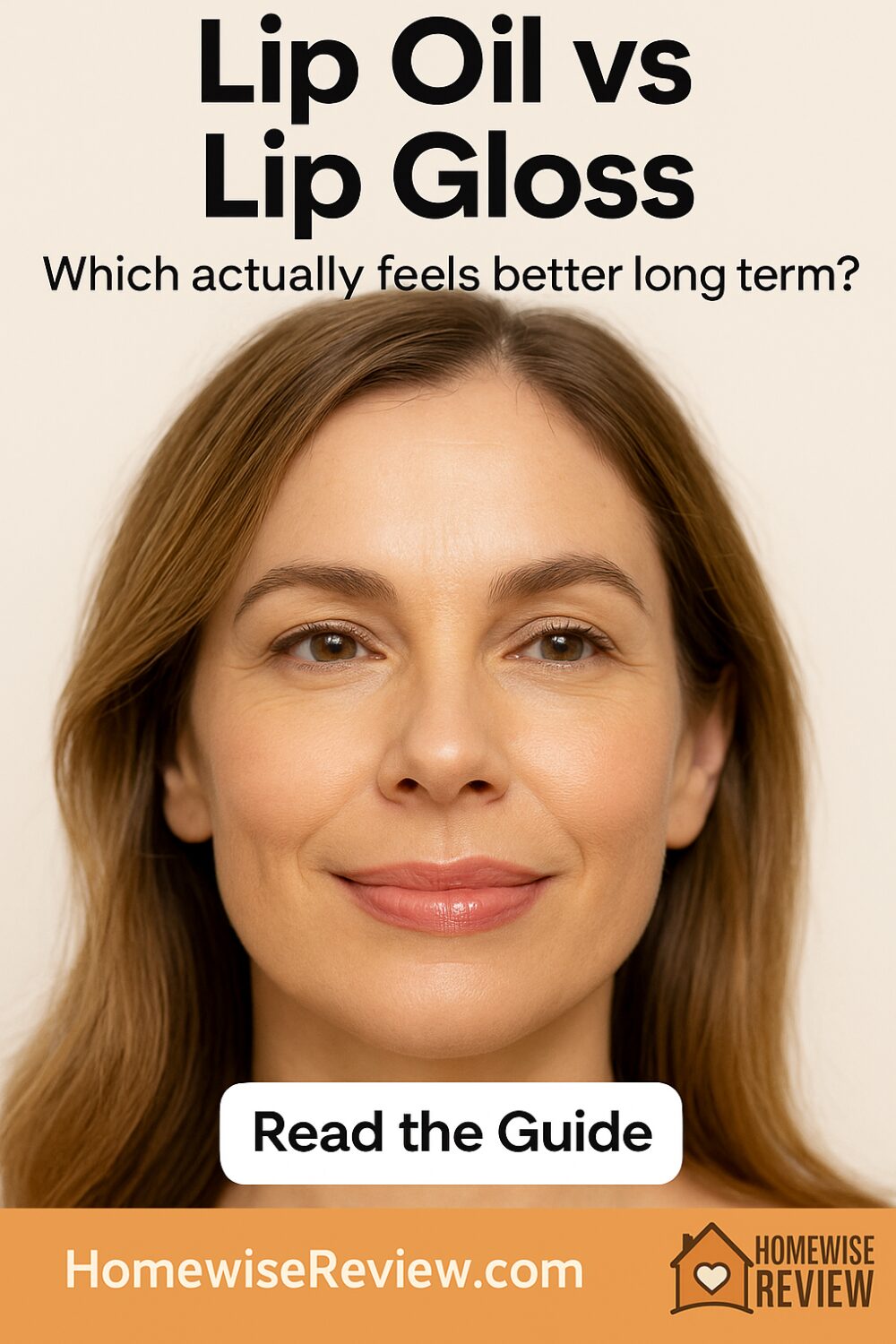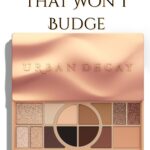
Lip oil and lip gloss look almost the same in selfies. Both look shiny, both make your lips pop with almost no effort, and both can sit in your bag next to your keys and receipts. So on the surface it feels like marketing. One is called “oil,” one is called “gloss,” and you’re supposed to believe one is skincare and one is makeup.
Here is where it actually matters. A lot of us are doing some version of this pattern: matte lipstick for work, then gloss or oil layered on top to keep things from cracking, then some kind of night balm so you don’t wake up with chapped lips. That’s a lot of layer traffic every single day. If the product you’re using in the “comfort” step is actually drying you out over time, you’re chasing hydration that never really comes back. That’s when you start noticing vertical lines around the lip line and tugging when you smile.
On the other hand, if you pick something that keeps lips soft but it’s so slippery that it melts into your lip lines and bleeds past the border, that’s annoying in a different way. You’re doing mirror checks all day. You’re wiping the edge of your mouth in meetings. If you’ve got any fine lines around your mouth, that can age you fast.
So instead of “Which one looks shinier,” the better question is, “Which one lets me wear color, look finished, and not destroy my lips by Friday.”
We’re going to walk through what lip oil actually is, what lip gloss actually is now versus the sticky early 2000s version, how each one behaves on real lips over time, and how to pick which one you should grab for daytime, night care, and going out.
Why this matters for comfort and lip health
In simple terms, lip gloss is usually a cosmetic finish. Lip oil is usually marketed as treatment plus shine. That difference sounds small, but it shows up in the ingredient base.
Most modern gloss formulas are built around lightweight emollients and film formers that sit on top of the lips and reflect light. Think shiny coat. You get instant payoff. The upside is you look done in seconds. The downside is that kind of film can block moisture from escaping, which sounds good, but if there is not a lot of actual nourishment under that film, you can get a rebound feeling of dryness once it wears off. A lot of people describe this as, “I feel addicted to my gloss. If I don’t reapply constantly, my lips feel tight.”
Lip oils are usually built on plant oils, esters, and sometimes balms or butters suspended in a thinner texture. So instead of only coating the surface, they try to soften the top layer of the lip. You’ll see words like jojoba oil, avocado oil, and sometimes squalane in those formulas. That can feel more like a conditioning step. The shine is still there, but it’s usually softer and more “juicy” than glassy.
Here is why that matters long term. If you are someone who gets peeling, cracking, or rough texture at the outer corners, a basic high-shine gloss might make you look good in the moment, but it will not repair anything. A decent lip oil can slowly calm that roughness over a few days of steady use. People who switch from constant gloss to oil-only for a week tend to say their lips feel more flexible and less scabby.
There is a flip side. Gloss, especially newer “non stick” glosses, usually wears longer per swipe. Lip oil soaks in, transfers, and fades faster, which means more reapplying. If you hate reapplying, you might actually overuse a heavier oil trying to stretch it, and then you feel greasy instead of comfy. So this is not “oil is good and gloss is bad.” It’s more about matching what your lips actually need.
How to figure out which one your lips prefer
This is the part most people skip. You can test this in two days without buying anything new.
Step 1. Morning and daytime test. Pick one product, either a gloss or an oil, and wear only that during the day for one full day. Do not sneak in a lip balm or a mask. Reapply as needed within reason, like a normal day. Pay attention to how your lips feel at 5 p.m. Do they feel gummy, tight, coated, itchy, or fine.
Step 2. Bare lip check. Before bed that same night, gently wipe off whatever is left so you’re not wearing product. Wait 20 minutes. Notice what your lips feel like bare. If they feel raw or tight, that product is not giving you long-term comfort, even if it looked amazing.
Step 3. Repeat with the other texture. Next day, same thing, but switch to the other category. Daytime wear, no extra balm, wipe, wait 20 minutes.
What you’re looking for is not which one looked cuter in the car selfie. You’re looking for which one left you with lips that felt soft and normal without anything on them. If gloss left you slightly dehydrated feeling by the end of the day, gloss is probably your “fun layer over lipstick for going out” product, not your daily comfort product. If oil felt sticky, tasted weird, and slid into the corners, then oil is probably your night couch product, not your office product.
This tiny test also tells you how often you really need to reapply. If your lips felt fine most of the day in gloss and only got cranky at bedtime, you’re probably okay to keep gloss as your default. If you were reapplying oil every 45 minutes and still felt dry, that oil is pretending to be skincare but it’s not actually doing the job.
When to grab lip oil and when to grab gloss
Think of lip oil as “conditioning shine.” Think of lip gloss as “styling shine.”
Lip oil usually wins in these situations:
Chronic dryness. If you wake up with flaking or you pick at your lips without thinking, oil is kinder for daily wear. The lightweight oils help soften the rough patches so they stop catching on your teeth.
Lip lines and feathering. Oils tend to move more, but they are less likely to create that sharp ring of color that settles into fine lines around the mouth. If feathering is your main complaint, sheer tinted oils can look softer at the edges.
No makeup days. On a bare face, oil looks like healthy lips, not like “I’m wearing makeup.” It reads less try-hard during errands, daycare drop off, gym parking lot, school pickup, all of it.
Lip gloss usually wins here:
You want instant shape. A good gloss gives obvious shine that makes lips look fuller and smoother right away. If you like that fuller look around the cupid’s bow, gloss is easier.
You’re layering over lipstick. Gloss grips to lipstick and makes it look fresher again. Oil on top of lipstick can break down the color and make it slide.
You need longer wear in public. Gloss formulas with a light film former will hang on through small sips, small talking, and general life. Most oils fade faster and need babysitting.
So the simple rule: oil when you’re trying to heal or maintain comfort, gloss when you’re trying to finish the look and get definition.
Quick comfort fixes versus long term lip habits
There are really two problems to solve. One is “My lips feel dry right now.” The other is “My lips are aging faster than the rest of my face around the mouth.”
For the first problem, fast comfort, gloss can actually feel better in the moment, even if your lips are already dry. You swipe, you get cushion, you get slip, you get instant relief. You feel done. That is why people get hooked. The product sits on top and blocks air so the soreness calms down short term. The issue is what happens after it wears off. If you notice that you go from “ahhh” to “tight and papery,” you’re soothing but not fixing.
For the second problem, long term lip health, oil is usually the better daily habit. Using a decent lip oil during the day and then something thicker overnight helps keep that smooth, flexible look in the actual lip surface. Over time, that can mean less cracking at the corners and less makeup settling in those little vertical lines above the top lip.
Fast fix idea. You can absolutely layer. Some people tap on a thin layer of oil first for comfort, blot once so you’re not slippery, then do gloss just in the center of the lips for shine and volume. That gives you the hydrated base plus the pretty finish without flooding past your lip line.
Long habit idea. If you’re over 40 and noticing fine lines around the mouth, the habit that matters is not “find the shiniest gloss.” It is “keep the skin around the mouth moisturized, not just the lip itself.” A lot of that creasing look is dryness in the skin right above the lip border, not only the lip. Treat that area the same way you treat under eyes. Gentle moisture, nothing harsh.
Troubleshooting common annoyances
Let’s be honest about the annoying parts.
“My hair keeps sticking to my face.” Classic gloss complaint. High-shine, high-grip gloss textures will grab onto loose hair. If that drives you crazy, look for gloss formulas that are described as “non sticky” or “balmy shine.” These usually sit closer to an oil-gloss hybrid and are less grabby.
“Everything tastes sweet and weird.” Some lip oils are heavily flavored. If taste bothers you, go for a simpler oil with fewer flavor additives. The plumping style oils and glosses often tingle on purpose. If you are sensitive, skip anything with “plump” in the name. That tingle is mild irritation creating short term swelling. Cute for photos, not great for lips that are already sore.
“It bleeds past my lip line.” This is usually a slip issue, not a color issue. Oils and thin glosses will creep outward if you already have fine lines around the border. One easy fix is to lightly tap a clear or skin tone lip liner around the edge first. You are basically building a tiny wall that slows that creep. You can also take a tiny bit of setting powder on a small brush and trace right outside the lip line, which helps stop movement.
“My lips keep peeling no matter what I use.” If nothing is helping, you might just be overdoing flavor oils, fragrances, or mint. Pull everything scented and use something plain for 48 hours. If peeling improves, keep the plain stuff for daily and use the fun scented gloss just when you want the look.
Final Thoughts
If you want pure shine, hold, and shape, gloss still wins. It gives you instant definition, a fuller looking lip, and it stays put longer when you’re out living life and not babysitting a mirror.
If you want lips that stay soft, flexible, and not angry by Friday, lip oil is usually kinder. It behaves more like daily maintenance. It will not always look as glassy, and you will reapply more, but most people find their lips feel better long term with oil in the rotation.
The smartest move is not “pick a team.” It is “assign jobs.” Keep a comfortable oil for workdays, errands, and bare-face days. Keep your favorite gloss for date night, pictures, and anything where you want that high-shine finish. When you treat them like two different tools instead of dupes, you stop fighting your lips and they actually look smoother with less effort.
See also
If feathering and little vertical lines around the mouth are your main complaint, look at products that are made for mature lips. Our guide to Best Lipstick for Older Women talks about formulas that do not bleed into fine lines and how to keep color from drifting. If undertone matching is the struggle and most nudes look chalky or washed out, the roundup of Best Lipsticks for Brown Skin breaks down flattering tones that still look natural, not grey or flat, especially in softer shiny finishes instead of full matte.
If you are building a whole face routine and you want lift without settling into smile lines, the step by step in Over 40 Makeup Routine That Lifts Without Caking shows how to handle base, cheeks, and lip area so everything looks smoother in daylight. Bleed control is also about set, not just liner, so the breakdown in Setting Powder vs Setting Spray: What to Pick explains how to lock in makeup without making the mouth area look dry or crackly. Dry lips almost always go with overall skin dehydration. If the rest of your face also feels tight after cleansing, start with barrier support. The picks in Best Moisturizer for Dry Skin focus on softer, longer lasting hydration instead of quick shine so your skin and lips are not fighting you all day.
FAQs
Is lip oil basically just lip gloss with a healthier sounding name?
Not exactly. Lip gloss is mainly about shine and finish. Lip oil usually has at least some conditioning ingredients meant to soften the actual lip surface. They can overlap, and some “glosses” now feel very balmy, but the intention is different. Gloss is makeup. Oil is comfort plus shine.
Will lip oil actually fix chapped lips?
It can help, especially if it includes nourishing oils and not just flavor. It is not magic if you are severely cracked, but steady use during the day plus a thicker night product usually leads to less peeling and less tugging over time. If you are extremely raw or bleeding, you should use something very plain and protective and avoid flavored or tingling formulas.
Why does gloss sometimes make my lips feel drier later?
Some gloss textures sit on top like plastic wrap. While that layer is on, lips feel cushioned. When it wears off, there is no actual moisture underneath, so you feel tight. That “constant reapply or I’m miserable” cycle is a sign you need something more nourishing under or instead of your gloss.
Which one is better if I have lip lines and my color keeps bleeding?
A thicker gloss with grip will usually stay where you put it better than a super thin oil. You can also pair either one with a clear or skin tone liner to build a border. Another trick is tapping a little setting powder just outside the lip line to lock down the area so shine does not travel.
Can I layer oil and gloss together?
Yes. A lot of people tap a thin layer of oil first for comfort, blot once, then add gloss in the center for shine and fullness. That gives you hydration plus the pretty finish without flooding into fine lines around the mouth.
Affiliate Disclosure
If you purchase through links on our site, we may earn a small commission at no extra cost to you.




